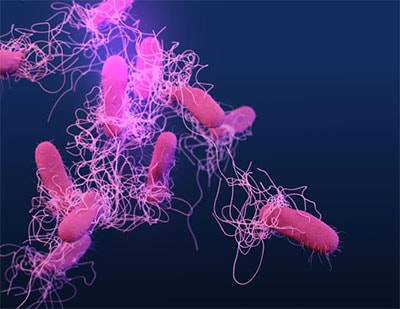Diagnostic and Public Health Testing
Diagnosing Salmonella infection requires testing a specimen (sample), such as stool (poop) or blood. Testing can help guide treatment decisions.
Steps in laboratory testing and reporting Salmonella infection
- Infection is diagnosed when a laboratory test detects Salmonella bacteria in stool, body tissue, or fluids. The test could be a culture that isolates the bacteria or a culture-independent diagnostic test (CIDT) that detects genetic material of the bacteria.
- CDC encourages laboratories to culture specimens with positive CIDT results. This process is called “reflex culturing.”
- Clinical diagnostic laboratories report the test results to the doctor and submit Salmonella isolates to state public health laboratories for serotyping and DNA fingerprinting.
- Public health laboratories report the results to CDC’s Laboratory-based Enteric Disease Surveillance and to PulseNet.
- Public health laboratories forward unusual serotypes to CDC’s National Salmonella Reference Laboratory for further characterization or confirmation.
Salmonella Serotypes
Salmonella are divided into serotypes according to structures on the their surface.
Some serotypes are only found in one kind of animal or in a single place. Others are found in many different animals and all over the world. A few serotypes can cause especially severe illnesses; most typically cause milder illnesses.
Serotyping has played an important role for decades in understanding the epidemiologic and molecular characterization of Salmonella. Today, modern genetic subtyping methods provide scientists with additional information that is used to determine the serotypes and to identify, investigate, and trace outbreaks.
PulseNet
State public health laboratories routinely subtype Salmonella isolates by serotyping and by whole genome sequencing (WGS)-based subtyping. The laboratories submit results from whole genome sequencing to a dynamic database maintained by PulseNet, a national network of public health and food regulatory agency laboratories coordinated by CDC.
PulseNet includes state health departments, local health departments, agricultural laboratories and federal agencies (CDC, the U.S. Department of Agriculture’s Food Safety and Inspection Service, and the U.S. Food and Drug Administration.
PulseNet data are available to participating health departments for comparing WGS profiles. Finding a group of infections with the same or very similar profiles could indicate an outbreak. Finding the same profile in a food could help link illness to a specific food source.

Culture: A growth of bacteria or other organism in a laboratory-controlled environment, such as a petri dish coated with nutrients to encourage growth
Serotype: A group within a single species of microorganisms, such as bacteria or viruses, which share distinctive surface chemical structures
Learn more about the importance of serotyping and CDC’s Salmonella Atlas, a first-of-its-kind report that charts over 40 years of laboratory-confirmed surveillance data on 32 Salmonella serotypes.